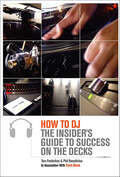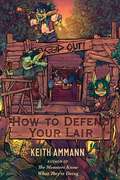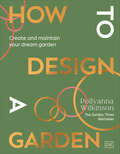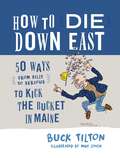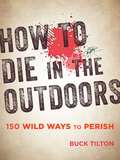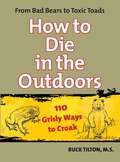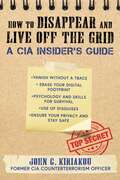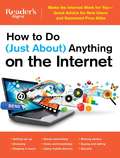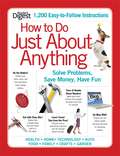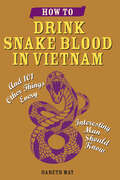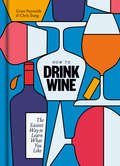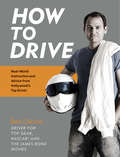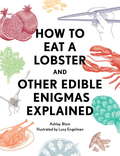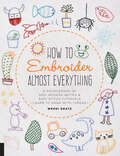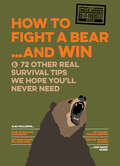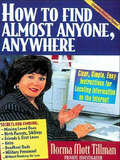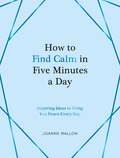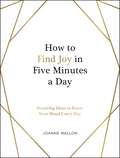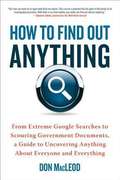- Table View
- List View
How to DJ: The Insider's Guide to Success on the Decks
by Tom Frederikse Phil Benedictus Point-BlankHow to DJ is the insider's guide to becoming a professional DJ. Written by two industry insiders who DJ and produce hit records throughout the world, this is the concise, how-to sourcebook that comes straight from real DJs and musicians. They explain and demonstrate everything you need to know---from the basics of what DJs do and how they got their careers off of the ground to the worldwide phenomenon of DJ/producers who work with the biggest names in the business and make the music in the charts today.-- top advice on how to DJ---from selecting what to spin to getting gigs to keeping your audience dancing-- technology made easy---what you need and how to set it up-- how the DJ and music business works and how to rise to the top-- how to make hit records at home-- interviews and tips from celebrity DJs including Tall Paul, Boy George, Tim Westwood, Andy Cato, Mr. C, Andy Wilson, BT, Jeremy Healy, Allister Whitehead, and Sasha.
How to Date Your Wardrobe: And Other Ways to Revive, Revitalize, and Reinvigorate Your Style
by Heather NewbergerIn a culture inundated by personal branding, a fashion stylist and creative consultant offers invaluable lessons, tips, and advice, to help you define your personal style in a whole new way, by enhancing not just how you look, but how you feel. Revive. Revitalize. Reinvigorate. These three seemingly simple precepts are at the heart of this sleek and uplifting guide to reclaiming your personal style. Throw away all those old tired rules, Heather Newberger says. Forget outmoded advice like dressing for your body shape or that a brand name is always better. In How to Date Your Wardrobe, Heather teaches you how to build a closet that reveals who you are. Too many people dress for a role instead of themselves and often invest in pieces they rarely wear. Following her advice, you’ll learn to define what you like and be able to choose clothing and accessories that express the best parts of your inner self. Heather shows, that no matter your gender identity or age, you can change your reflection. Best of all, you’ll find new ways to love every piece of clothing you own. How to Date Your Wardrobe includes 30 eye-catching illustrations from Hilary Fitzgerald Campbell, whose art has appeared in numerous media outlets, including The New Yorker and the New York Times.
How to Defend Your Lair (The Monsters Know What They’re Doing #4)
by Keith AmmannDefend yourself and protect your assets in a lair that feels as real and alive as your monsters with advice from Keith Ammann, author of The Monsters Know What They&’re Doing: Combat Tactics for Dungeon Masters. The world is a dangerous place—especially when you&’re up to no good. Whether you&’re a rampaging monster, a calculating mastermind, or the current possessor of the Golden MacGuffin, someone&’s going to come at you. Probably more than one someone. You can&’t know when, but you can choose where. You need to be ready. You need a lair. In How to Defend Your Lair, gamemaster Keith Ammann pulls back the curtain on an underrated but crucial part of any tabletop roleplaying game: the theater of battle. Say goodbye to encounters in randomly generated dungeons and hello to a game in which where the fight takes place is just as important as who is doing the fighting. This book teaches you how to use real-world principles of building security and area defense to create strongholds infused with flavor, informed by narrative, and complex enough to force your players to think strategically. You&’ll look at the strengths and weaknesses of both defenders and potential attackers, creating spaces that are strong enough to keep out ordinary intruders...and to provide thrilling challenges to extraordinary ones. Including more than a dozen fleshed-out sample strongholds, How to Defend Your Lair is a crucial resource for any RPG gamemaster who wants to push players to think about how to solve problems before running at them head-on.
How to Design a Garden: Create and Maintain Your Dream Garden
by Pollyanna WilkinsonDesign the garden of your dreams with the expertise of award-winning garden designer Pollyanna Wilkinson.How to Design A Garden shows you how to untap your garden’s potential and customize the design to suit you and your space: whether that be an extension of your living space for parties and al fresco dining or a calming oasis to relax in.Equipped with all you need to know about light, focal points, hardscaping, and planting, you’ll have the skills to create a mood board, design layout, choose paving, furniture, and plant combinations. Polly expertly guides you to understand how the elements in your garden will work together as one – and she is not shy to share her opinions on certain design dos and don'ts!Once you’ve designed your garden, month-by-month growing guides help you to nurture it, so you can enjoy your dream space for years to come.
How to Die Down East: 50 Ways (From Silly to Serious) to Kick the Bucket in Maine
by Buck TiltonMaine is certainly an exciting place, with a plethora of outdoor activities to pursue. It&’s also generally a safe place and most of those activities can be done by those with little to no experience. Don&’t let that lull you into a false sense of security however, there are numerous ways to perish in Maine&’s outdoors. Now, renowned wilderness medicine expert and storyteller Buck Tilton casts his glance on these dangers. Tongue planted firmly in cheek, Tilton takes a humorous look at just how you might die in Maine, and what he finds runs the gamut from downright deadly to uncomfortable, but unlikely to kill, to just plain silly. Some of nature&’s methods are distinctly possible without proper precautions, from rogue waves to rip currents to great white sharks. Others amount to simply wishing you were dead, like stepping on a sea urchin. And others cross the boundary into the nonsensical, such as being singled out by Sasquatch. Broken into sections depending on severity and likeliness of actually dying, all the entries are told with a storyteller&’s ear for humor and whimsy. Many are illustrated in full color by Maine cartoonist David Jacobson
How to Die in the Outdoors: 150 Wild Ways to Perish
by Buck TiltonThe Book That Makes Dying by Heart Attack Seem Downright BoringSimply by living a normal life, you have an excellent chance of becoming yet another statistic on the list of leading causes of death. But Buck Tilton prefers to ponder the alternatives. In How to Die in the Outdoors, he presents 150 more interesting and unique ways to perish, from snake bite, elephant foot, rhino horn, and more! With witty prose, Tilton describes not only the details of how you can die—some intriguingly gory, yet all based on facts—but also ways to avoid death should a life-threatening situation arise before you&’re ready to leave this world for whatever afterlife there may be.
How to Die in the Outdoors: From Bad Bears to Toxic Toads, 110 Grisly Ways to Croak
by Buck TiltonBy living a normal, boring life like most people do, one has an excellent chance of becoming yet another statistic on the proverbial list of the leading causes of death. Of course, the process can be accelerated a bit by eating lots of fat, giving up exercise, smoking, drinking heavily (not water), and worrying. Buck Tilton prefers to ponder the alternatives. In How to Die in the Outdoors, he presents us with 110 far more interesting and unique ways to perish: snake bite, elephant foot, walrus tusk, rhino horn, and many, many more. In a straightforward style laced with his trademark wit, and presented in easy to understand terms, Tilton describes not only the details of how one can die, some intriguingly gory and all based—more or less—on facts, but also the ways to avoid death should life-threatening situations arise in which one is not ready to check out of this world and into whatever afterlife there may be.
How to Disappear and Live Off the Grid: A CIA Insider's Guide
by John KiriakouWith an experienced CIA officer as your teacher, you&’ll gain the knowledge and necessary tools to protect yourself and the ones you love.No matter where we go, we leave tracks and clues of our existence without even knowing. Our electronic footprint becomes our invisible trail. In this day in age where the world seems to be at our fingertips and social media plays a huge role in our daily lives, it&’s hard not to leave part of our digital selves for others to find.Whether you&’re fascinated by the idea of disappearing, want to erase your digital footprint, or simply concerned about your safety and privacy, knowing how to become invisible is a survival skill that will come in handy.Through the easy-to-follow instructions, tips, tricks, and professional anecdotes in How to Disappear and Live off the Grid: A CIA Insider's Guide, you&’ll learn to vanish without a trace from John Kiriakou, a former CIA counterterrorism officer and senior investigator for the Senate Foreign Relations Committee responsible for the capture of Abu Zubaydah.
How to Disappear: Erase Your Digital Footprint, Leave False Trails, And Vanish Without A Trace
by Eileen Horan Frank AhearnFor the first time in paperback we bring you the authoritative and comprehensive guide for people who seek to protect their privacy as well as for anyone who&’s ever entertained the fantasy of disappearing—whether actually dropping out of sight or by eliminating the traceable evidence of their existence.Written by the world&’s leading experts on finding people and helping people avoid being found, How to Disappearcovers everything from tools for disappearing to discovering and eliminating the nearly invisible tracks and clues we tend to leave wherever we go. Learn the three keys to disappearing, all about your electronic footprints, the dangers and opportunities of social networking sites, and how to disappear from a stalker.Frank Ahearn and Eileen Horan provide field-tested methods for maintaining privacy, as well as tactics and strategies for protecting personal information and preventing identity theft. They explain and illustrate key tactics such as misinformation (destroying all the data known about you); disinformation (creating fake trails); and, finally, reformation—the act of getting you from point A to point B without leaving clues.Ahearn illustrates every step with real-life stories of his fascinating career, from undercover work to nab thieving department store employees to a stint as a private investigator; and, later, as a career &“skip tracer&” who finds people who don&’t want to be found. In 1997, when news broke of President Bill Clinton&’s dalliance with a White House intern, Ahearn was hired to find her. When Oscar statuettes were stolen in Beverly Hills, Ahearn pinpointed a principal in the caper to help solve the case. When Russell Crowe threw a telephone at a hotel clerk in 2005, Ahearn located the victim and hid him from the media.An indispensable resource not just for those determined to become utterly anonymous, but also for just about anyone in the brave new world of on-line information, How to Disappear sums up Ahearn&’s dual philosophy: Don&’t break the law, but know how to protect yourself.
How to Do (Just About) Anything on the Internet
by Editors of Reader's DigestGoogle, Twitter, Skype--are these and other technological terms a foreign language to you? If so, it's time to learn the vocabulary and find out how the internet can make your life easier, better--and a lot of fun! In an easy to use format, here are useful and straightforward answers to hundreds of questions about getting online and using the world wide web. *Inside You'll discover how to: *Choose the right computer and internet deal for you *Find Out anything you want to know on the web * Your Privacy--and avoid scams *Keep in Touch with friends and family *Use Facebook and other social networks *Store and Edit your digital photos online *Buy anything you want securely *Search the best holiday rental, doctor, garden center or whatever else you need
How to Do Just About Anything
by Editors of Reader's DigestWouldn't it be nice to have a single volume that tells you how to, say, learn the basics of calligraphy, develop an aerobic exercise routine, and increase your computer memory? How to Do Just about Anything gives you all these plus more than 1,200 clearly laid- out directions for everything from home repair and appliance maintenance to answers to etiquette questions. This browser's feast is more than a match for the Internet, with every page serving up something to capture your interest. (Look up Pilot lights and you'll probably find yourself reading about how easy is it to make Pimientos.) A sampling of the things you'll learn to do, organized here by type: Home, garden, and auto Make a simple cushion cover; build and maintain a pond; cut gasoline costs Food and drink Match pasta shapes to sauces; make your own butter; cure a hangover Health and fitness Measure your blood pressure; give CPR; learn Pilates Clothing and grooming Store clothes properly; tie a bow tie; banish dandruff Behavior and etiquette Impress a date; deflect bullying; escape a bore Family matters Draw up a family tree; organize a successful reunion; housetrain a pet Sports and games Make sense of rugby; win at Scrabble; work a cryptic crossword Arts and crafts Draw a face; learn embroidery basics; make silk flowers Nature Identify animal footprints; choose the right campsite; survive an avalanche Electronics and the Web Unfreeze an iPad; start a blog; sell goods on eBayEasy-to-understand instructions (often step-by-step) can turn even the most all-thumbs adult or youngster into an enthusiastic do-it- yourselfer. All told, How to Do Just About Anything is a practical-and highly enjoyable-book for the whole family.
How to Drink Snake Blood in Vietnam: And 101 Other Things Every Interesting Man Should Know
by Gareth MayBe that guy who amazes everyone with his knowledge of strange and fascinating facts from around the world . . .Chock-full of mind-blowing trivia from all over the globe, this book will make you the most interesting guy at any gathering. Captivate the crowd with fascinating facts, exciting adventures, and intriguing anecdotes, such as:• How to survive a shark attack• Best places to eat monkey brains• Drinking vodka like a Russian• How to say “cheers” in any language• Recognizing venomous snakes• Etiquette for nude beaches, and much moreFrom essential tips and tricks to entertaining stories, this is the ultimate collection of badass wisdom no man should leave home without.
How to Drink Wine: The Easiest Way to Learn What You Like
by Grant Reynolds Chris StangFrom grape to glass, this highly readable, charmingly illustrated guide will teach you everything you need to know to enjoy wine. &“How to Drink Wine demystifies this topic, taking out the BS and replacing it with fun.&”—Mike D, the Beastie Boys Everybody knows that the world of wine can be vast and intimidating and complex. But what few people seem to know is where to start when it comes to learning the basics. How to Drink Wine solves that problem. The path to drinking wine with confidence begins with this very informative, very relatable, very entertaining book, thanks to award-winning sommelier and restaurateur Grant Reynolds and acclaimed writer and founder of The Infatuation, Chris Stang. By reading How to Drink Wine, you will: • Acquire some foundational terminology. Cuvée, maceration, sul tes . . . what does it all mean? • Learn of the twenty-nine wines you need to know—and about important producers. • Find answers to questions you might be embarrassed to ask, like exactly how is rosé made? • Start to pair wines with your life instead of your plate. • Be able to navigate a wine list and/or store. You probably already know what you like to drink. This book will help you better understand why. And as a result, your knowledge, curiosity, and wine collection will expand. So will your number of friends.
How to Drive: Real World Instruction and Advice from Hollywood's Top Driver
by Ben CollinsHere's the ultimate guide to being the best—and safest—driver possible. And an absolute must for everyone with a learner's permit. Former Top Gear Stig and professional driver Ben Collins shares expert skills culled from a twenty year career as one of the best drivers in the world, famous for racing in the Le Mans series and NASCAR, piloting the Batmobile, and dodging bullets with James Bond. Refined over thousands of hours of elite-level performance in the physics of driving, his philosophy results in greater control and safer, more efficient and fun driving for all skill levels.
How to Eat a Lobster: And Other Edible Enigmas Explained
by Ashley Blom Lucy EngelmanLearn the answers to modern food and etiquette questions with this beautifully illustrated guide. For adventurous foodies everywhere, How to Eat a Lobster is the perfect handbook for handling every tricky dining situation you can imagine (and a few you can’t) with grace, style, and minimal splatter. With easy-to-follow instructions and helpful illustrations, you’ll learn the answers to 50 food-related questions you’ve been afraid to ask. (What do you do when crawfish arrive? Twist and snap off the head. Peel the tail and pull out the meat. Then suck the juices from the head. Seriously: you’re supposed to!) Equal parts cheat sheet and cheerleader, How to Eat a Lobster not only shows you how to open a coconut—it shows that you can! Topics include: How to Eat Crawfish How to Eat Raw Oysters How to Eat Escargots How to Open a Coconut How to Slice a Mango How to Use Chopsticks How to Hold a Wineglass How to Use Bread as a Utensil How to Eat Sushi How to Recover from a Tongue Burn And more!
How to Embroider Almost Everything: A Sourcebook of 500+ Modern Motifs & Easy Stitch Tutorials
by Wendi GratzThis embroidery sourcebook teaches you to turn a few basic stitches into endless creative designs—from alligators and bicycles to yucca plants and zebras.In How to Embroider Almost Everything embroidery designer Wendi Gratz shares more than five hundred inspiring, fun, and sophisticated stitch motifs that offers a fresh take on embroidery. Gratz offers fully illustrated instruction for each design, plus step-by-step tutorials in each of the easy stitch techniques you’ll need.You can re-create the motifs exactly as shown using the accompanying templates and stitch guides, or give them your own creative spin by changing details and colors to suit your own style.This giant reference volume includes:A detailed checklist of everything you’ll need to embark on your stitch journey: threads, needles, fabric, and more.Step-by-step tutorials for essential stitches and other techniques for creating the motifsAnswers to common questions and invaluable tips and tricks.500+ modern motifs for almost everything, including people and pets, trees and flowers, everyday objects, food, home, and more.Each book in the Almost Everything series offers a fun, comprehensive, and charmingly illustrated visual directory of ideas to inspire skill.
How to Escape Lifetime Security and Pursue Your Impossible Dream: A Guide to Transforming Your Career
by Kenneth AtchityFor the Type C, or creative, personalities who want their work to "fill" their deepest creative urges, this is the frontline guide to making the transition from a secure and soulless job to a life built around a creative dream. Individuals learn how to follow the mind's eye to construct a life that conforms to personal vision, steal time to make creative dreams come true, use as assets the resources around them, and turn creative goals and objectives into an effective life plan. Introduces the catchy buzzword "Type C"Allworth Press, an imprint of Skyhorse Publishing, publishes a broad range of books on the visual and performing arts, with emphasis on the business of art. Our titles cover subjects such as graphic design, theater, branding, fine art, photography, interior design, writing, acting, film, how to start careers, business and legal forms, business practices, and more. While we don't aspire to publish a New York Times bestseller or a national bestseller, we are deeply committed to quality books that help creative professionals succeed and thrive. We often publish in areas overlooked by other publishers and welcome the author whose expertise can help our audience of readers.
How to Fall in Love with Yoga: Move. Breathe. Connect.
by Sarvesh ShashiA complete workout for the mind, body, and soul with classic, authentic yoga from the country of its origin.Authentic, restorative, and holistic, How to Fall in Love with Yoga is a stroll through the world of yoga, where Sarvesh Shashi, the author, encourages readers to experience the different facets of the practice. Through four key goals and accompanying poses and flows, the author does a deep dive into the basics of the practice. It is contemplative and inclusive, peppered, on occasion, with personal notes and experiences.How to Fall in Love with Yoga is as much about the body as it is about the spirit and as much about fitness as it is about mindfulness. Dive into this calming yoga book to discover:-A step-by-step yoga in classic DK style.-Complex poses are made simple in an illustrative style.-Features benefits and notes from Sarvesh Shashi for beginners.-Detailed meditative techniques at the end of each chapter to bring focus to mindfulness.-Keynotes from Sarvesh Shashi, who shares his experiences and knowledge, help readers understand the key philosophy of yoga.Not bound by age, school, or style, it will reach into the heart of yoga, cutting through all the noise to share with the reader what is true to the authentic and original form of the practice. The book will contain a youthful flavor as it walks the yogi – for there is a yogi within all of us – through different postures while providing the reader with context, additional information, and useful tips. The poses and goals are practical and aim to build a love for the practice. It is why each section ends with meditation to help the practitioner relax and focus at the end of their goal.
How to Fight a Bear . . . and Win: & 72 Other Real Survival Tips We Hope You'll Never Need (Uncle John's Bathroom Reader)
by Bathroom Readers' InstituteA humorous guide to surviving in the wilderness, that also might make you want to avoid the wilderness forever.For more than twenty-five years, Uncle John&’s Bathroom Reader has helped you learn amazing things you didn&’t know. Now, Uncle John will show you how to do things you didn&’t know how to do . . . and probably should never, never, never actually do, unless you&’re in a survival situation and really, really, really need to do. It&’s How to Fight a Bear . . . and Win. A new approach to survival guides and how-to books, this book provides step-by-step instructions for how to make do in any rugged terrain. But if you&’re expecting &“how to start a fire,&” think again. This isn&’t the kind of book that will tell you how to make a fire by rubbing two sticks together—it will tell you how to make a fire using a car battery. It will also tell you:· How to swing from a vine like Tarzan· How to land an airplane in an emergency· How to fight a bear . . . and win· How to perform emergency surgery in the woods· How to identify what insects you can—and cannot—eat And lots, lots more
How to Find Almost Anyone, Anywhere
by Norma Mott TillmanLearn a PI’s secrets for finding missing loved ones, birth parents, first loves, heirs, military personnel, and others—without breaking the law.A private investigator provides the information by which tens of millions of Americans separated by adoption will be able to find a lost relative. Here also are the resources for those needing more information about someone. Whether you are looking for an old friend, a dead-beat dad, a debtor, father/mother or sibling, this is the book that may change your life.
How to Find Calm in Five Minutes a Day: Inspiring Ideas to Bring You Peace Every Day
by Joanne MallonThis book includes over 60 prompts and ideas to help you pause for peace and connect to calm every single day - and each tip takes no longer than five minutes Pockets of calm are all around us, even on the busiest of days - and they're easy to find when you know where to look. All you need is five minutes. Guiding you through each stage of your day, these soothing rituals will help you to recentre yourself and rise above everyday stresses. Tips include:- How to incorporate mindfulness into your routine- Starting the day with a relaxation exercise and a calming mantra- Visualizing what calm looks like to you- Writing down your worries to gain focus and perspectiveEven the smallest moment of calm can transform your outlook, so whether you follow one tip or many, you're sure to de-stress, boost your well-being and find clarity and calm every day.
How to Find Calm in Five Minutes a Day: Inspiring Ideas to Bring You Peace Every Day
by Joanne MallonThis book includes over 60 prompts and ideas to help you pause for peace and connect to calm every single day - and each tip takes no longer than five minutes Pockets of calm are all around us, even on the busiest of days - and they're easy to find when you know where to look. All you need is five minutes. Guiding you through each stage of your day, these soothing rituals will help you to recentre yourself and rise above everyday stresses. Tips include:- How to incorporate mindfulness into your routine- Starting the day with a relaxation exercise and a calming mantra- Visualizing what calm looks like to you- Writing down your worries to gain focus and perspectiveEven the smallest moment of calm can transform your outlook, so whether you follow one tip or many, you're sure to de-stress, boost your well-being and find clarity and calm every day.
How to Find Joy in Five Minutes a Day: Inspiring Ideas to Boost Your Mood Every Day
by Joanne MallonJoy is all around us. It’s in the first sip of a cup of tea, the beauty of a sunrise, or the simple pleasure of a deep breath, and it’s easy to find when you know where to look. All you need is five minutes. This book includes over 60 prompts and ideas to help you to find joy every single day. Taking you through your morning, your afternoon and your evening, these tips will help you to elevate your mood and liven up your routine – and each one takes no longer than five minutes.Tips include:Setting an intention for your dayPerforming a small act of kindnessEating outdoors in the fresh airTrying a grounding ritualEven the smallest moment of positivity can transform your outlook, so whether you follow one tip or many, you’re sure to lift your spirits and find a small oasis of happiness every day.
How to Find Joy in Five Minutes a Day: Inspiring Ideas to Boost Your Mood Every Day
by Joanne MallonJoy is all around us. It’s in the first sip of a cup of tea, the beauty of a sunrise, or the simple pleasure of a deep breath, and it’s easy to find when you know where to look. All you need is five minutes. This book includes over 60 prompts and ideas to help you to find joy every single day. Taking you through your morning, your afternoon and your evening, these tips will help you to elevate your mood and liven up your routine – and each one takes no longer than five minutes.Tips include:Setting an intention for your dayPerforming a small act of kindnessEating outdoors in the fresh airTrying a grounding ritualEven the smallest moment of positivity can transform your outlook, so whether you follow one tip or many, you’re sure to lift your spirits and find a small oasis of happiness every day.
How to Find Out Anything
by Don MacleodIn How to Find Out Anything, master researcher Don MacLeod explains how to find what you're looking for quickly, efficiently, and accurately--and how to avoid the most common mistakes of the Google Age. Not your average research book, How to Find Out Anything shows you how to unveil nearly anything about anyone. From top CEO's salaries to police records, you'll learn little-known tricks for discovering the exact information you're looking for. You'll learn: * How to really tap the power of Google, and why Google is the best place to start a search, but never the best place to finish it. * The scoop on vast, yet little-known online resources that search engines cannot scour, such as refdesk.com, ipl.org, the University of Michigan Documents Center, and Project Gutenberg, among many others. * How to access free government resources (and put your tax dollars to good use). * How to find experts and other people with special knowledge. * How to dig up seemingly confidential information on people and businesses, from public and private companies to non-profits and international companies. Whether researching for a term paper or digging up dirt on an ex, the advice in this book arms you with the sleuthing skills to tackle any mystery.
